By Cecille Jones, Monroe Gardener Volunteer
This article appeared in the March 2021 Issue of Gardening in Orange County.
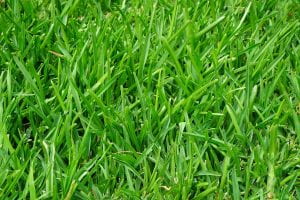 Are your tired of mowing and weeding your lawn? Are you suffering from suburban guilt because your yard isn’t as lush a fairway as your neighbor’s? It’s time to let go of that nagging sense of failure.
Are your tired of mowing and weeding your lawn? Are you suffering from suburban guilt because your yard isn’t as lush a fairway as your neighbor’s? It’s time to let go of that nagging sense of failure.
This has nothing to do with laziness and everything to do with loving – and taking care of – yourself and the environment. With a little knowledge and common sense, you can have a beautiful yard without applying harmful and expensive herbicides and pesticides that could seep into our ground water, without using gas- or electric-powered lawn mowers that pollute our atmosphere, and without spending precious weekend hours toiling under the sun when you could be relaxing and enjoying your surroundings.
Forget the wide variety of grasses readily available at big box stores. Think perennial evergreen groundcovers instead. These plants serve more useful purposes than you can count.
If you have a large plot of grass, don’t fret. Start with a problem patch that’s about 10 ft X 12 ft and keep expanding your grid over the years. Beautiful gardens don’t grow overnight. Besides, what would you rather have? A garden you don’t enjoy – and maybe even resent – because you’re too busy mowing, weeding and watering or a practically maintenance-free yard that’s rich in color, form, and texture?
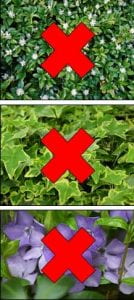
But wait. Don’t rush off and default to planting pachysandra, English ivy or myrtle/periwinkle to replace your grass. Let’s think this through.
Did you know that this trio of groundcovers is old hat – and worse, invasive? They out-compete many plants, threaten biodiversity and are destructive to the ecosystem. Plus, these plants blanket almost every other yard in suburban communities so much so that they deserve to be called the vinyl siding of groundcover plants. (If I knew the name of the clever mind that coined this phrase, I’d give full attribution.) Wouldn’t you rather have gorgeous evergreen groundcovers that aren’t invasive, aren’t common and are almost completely self-sustaining?
There are other reasons why perennial groundcovers are a good choice for your landscape.
- First, unlike lawns, they don’t have to be mowed. This fact alone is a strong selling point.
- Second, many of them won’t die during the cold winter months. That means they won’t leave the ground exposed and open to weed seeds germinating. When other plants are completely dormant during the cold months, it’s always refreshing and hopeful to see the green foliage of perennial groundcovers.
- Third, many evergreen groundcovers have fibrous roots that help limit soil erosion.
- Fourth, they act as living mulch because they cover the soil and are exceptional in out-competing many weeds.
- Finally, there are enough hard-working and beautiful varieties to choose from that unlike a monotonous expanse of sod, evergreen perennial groundcovers add texture, color, and interest to your yard.
An added bonus is that some of these groundcovers produce flowers that are delightful to humans and beneficial to many species of pollinators.
Depending on your needs, there are three main categories of perennial evergreen groundcovers: flowering, sun-loving and shade-loving.
Flowering Evergreen Groundcovers
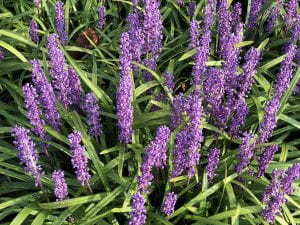 Lilyturf (Liriope muscari): This tough, relatively fast-growing plant has a grass-like appearance, grows from 6 – 12” tall and spreads 12 – 18” wide. It is hardy down to -30 degrees F and prefers partial or full shade, but will grow in a sunny location. It’s great for sloped sides of the garden or areas under large trees with extensive root systems. Varieties with solid green or variegated leaves produce violet-blue flower spires in the spring. As long as it’s planted in moist, well-drained soil, it will endure heat, drought and salt spray.
Lilyturf (Liriope muscari): This tough, relatively fast-growing plant has a grass-like appearance, grows from 6 – 12” tall and spreads 12 – 18” wide. It is hardy down to -30 degrees F and prefers partial or full shade, but will grow in a sunny location. It’s great for sloped sides of the garden or areas under large trees with extensive root systems. Varieties with solid green or variegated leaves produce violet-blue flower spires in the spring. As long as it’s planted in moist, well-drained soil, it will endure heat, drought and salt spray.
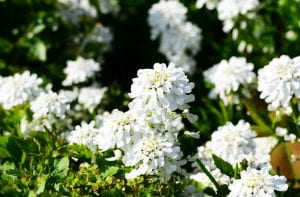 Candytuft (Iberis sempervirens): If you want a ground-hugging flowering perennial as pathway edging where there’s full sun or partial shade, look for candytuft. Best planted in the early fall, candytuft will brighten your garden in April and May with masses of white flowers against dark green foliage. It’s great for drawing bees and butterflies to your landscape while keeping deer and rabbits away. Not everyone likes its floral scent, but it’s a good groundcover suitable in Zones 4 to 8. These plants crave well-drained soil.
Candytuft (Iberis sempervirens): If you want a ground-hugging flowering perennial as pathway edging where there’s full sun or partial shade, look for candytuft. Best planted in the early fall, candytuft will brighten your garden in April and May with masses of white flowers against dark green foliage. It’s great for drawing bees and butterflies to your landscape while keeping deer and rabbits away. Not everyone likes its floral scent, but it’s a good groundcover suitable in Zones 4 to 8. These plants crave well-drained soil.
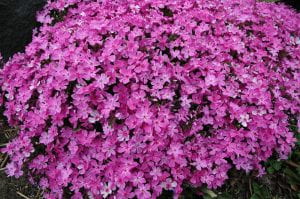 Creeping phlox (Phlox subulata): Considered one of the most colorful of groundcovers, these plants bloom profusely with magenta, purple-blue or white flowers in mid to late spring. They have dark green, needle-like foliage which are covered when in bloom for 3 – 4 weeks. This eastern North America native is deer resistant, trouble-free and extremely tolerant of the cold down to -40°F. You’ll love the hummingbirds and butterflies it draws to your yard. It thrives in full sun but tolerates dappled shade. It grows well in sandy or gravely soils and is drought tolerant once established. This plant is commonly used in rock gardens and sloped areas.
Creeping phlox (Phlox subulata): Considered one of the most colorful of groundcovers, these plants bloom profusely with magenta, purple-blue or white flowers in mid to late spring. They have dark green, needle-like foliage which are covered when in bloom for 3 – 4 weeks. This eastern North America native is deer resistant, trouble-free and extremely tolerant of the cold down to -40°F. You’ll love the hummingbirds and butterflies it draws to your yard. It thrives in full sun but tolerates dappled shade. It grows well in sandy or gravely soils and is drought tolerant once established. This plant is commonly used in rock gardens and sloped areas.
Here are other flowering groundcovers to consider. Thick, succulent, drought- and deer-resistant, sedums (Sedum spp.) are among the best-known evergreen groundcovers. Look for Dragon’s Blood, Blue Spruce and Lime Twister because of their interesting foliage and flower colors. If you need a plant with height, there’s wall germander (Teucrium chamaedrys), a shrubby perennial that’s hardy, drought-tolerant, pollinator-friendly and deer resistant. On the other end of the spectrum, there’s flowering thyme (Thymus spp.) which grows only between 1 – 3” tall depending on the variety. If you want this plant to serve a dual purpose, you can choose the culinary variety of fragrant thyme to flavor your dishes.
Sun-loving Evergreen Groundcovers
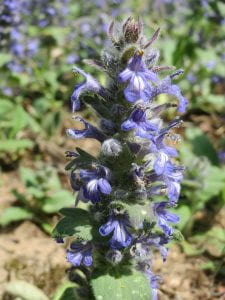 Bugleweed (Ajuga reptans): From green-leaved to bronze, purple or even variegated, there are literally dozens of varieties of bugleweed. There are also cultivars with crinkled leaves. With their spikes of purple-blue flowers, this groundcover is showy and colorful even when it’s not in bloom. Loved by bees when in flower, these hardy creepers survive -40°F weather. Of course, no mowing is required for this stalwart perennial that can spread to form a satisfyingly thick mat.
Bugleweed (Ajuga reptans): From green-leaved to bronze, purple or even variegated, there are literally dozens of varieties of bugleweed. There are also cultivars with crinkled leaves. With their spikes of purple-blue flowers, this groundcover is showy and colorful even when it’s not in bloom. Loved by bees when in flower, these hardy creepers survive -40°F weather. Of course, no mowing is required for this stalwart perennial that can spread to form a satisfyingly thick mat.
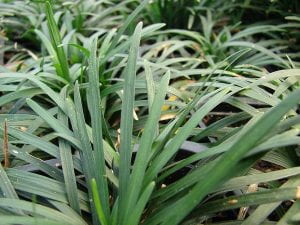 Mini mondo grass (Ophipogon japonicus ‘Nana’): If you can’t quite forego the look of turf and patience is not one of your virtues, try this petite evergreen groundcover that’s the smallest of the small. It’s only hardy down to -10°F, but the green tufts of mini mondo could look spectacular in any garden. It grows to only 4” tall and creates quick cover under full sun. It’s also recommended for use between stepping stones and around the base of trees. When used in this way, the mini mondo grass is a more lasting, less expensive alternative to gravel, shredded bark or other mulches. Just know that this is a clumping evergreen, meaning it won’t form a continuous, undifferentiated carpet of leaves like the bugleweed.
Mini mondo grass (Ophipogon japonicus ‘Nana’): If you can’t quite forego the look of turf and patience is not one of your virtues, try this petite evergreen groundcover that’s the smallest of the small. It’s only hardy down to -10°F, but the green tufts of mini mondo could look spectacular in any garden. It grows to only 4” tall and creates quick cover under full sun. It’s also recommended for use between stepping stones and around the base of trees. When used in this way, the mini mondo grass is a more lasting, less expensive alternative to gravel, shredded bark or other mulches. Just know that this is a clumping evergreen, meaning it won’t form a continuous, undifferentiated carpet of leaves like the bugleweed.
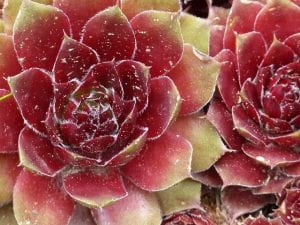 Hens and Chicks (Sempervivum tectorum): We don’t normally think of succulents as being cold hardy, but most hens and chicks are hardy down to -30°F. If you hate watering plants, you’ll appreciate these drought-tolerant perennials. They’re not normally grown for their flowers, but they do occasionally produce spires of colorful blooms in summer. There are many cultivars that come in a wide variety of colors and forms. If you want color, lean toward the eye-catching red or blue hens and chicks. If you want form, there are cobweb- and green wheel-shaped hens and chicks. None grows taller than 8 – 10” in height. You can readily spread them by digging up the offsets and planting them elsewhere in your garden.
Hens and Chicks (Sempervivum tectorum): We don’t normally think of succulents as being cold hardy, but most hens and chicks are hardy down to -30°F. If you hate watering plants, you’ll appreciate these drought-tolerant perennials. They’re not normally grown for their flowers, but they do occasionally produce spires of colorful blooms in summer. There are many cultivars that come in a wide variety of colors and forms. If you want color, lean toward the eye-catching red or blue hens and chicks. If you want form, there are cobweb- and green wheel-shaped hens and chicks. None grows taller than 8 – 10” in height. You can readily spread them by digging up the offsets and planting them elsewhere in your garden.
Other sun-loving evergreen groundcovers include the rock cotoneaster (Cotoneaster horizontalis) which have soft sprays of green leaves. All cultivars of this plant reach 2 – 3’ in height, so if you have a sloped area, consider it covered. Just know that If the weather dips below -20°F, this plant may only be semi-evergreen. For a shorter groundcover that’s only about 6 -12” tall, you can plant bearberry (Arctostaphylos uva-rusi). It has dark, glossy green leaves. Fully hardy down to -40°F, this plant spreads out its low, arching branches and attracts birds and other wild creatures when it produces dark, red cherries.
Evergreen Groundcovers for Shade
Few gardens are without shady areas, but that doesn’t mean your only options are gravel or mulch. There are enough perennial evergreen plants that thrive in full to part shade to get you covered.
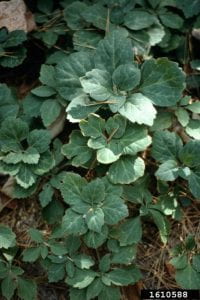 Allegheny spurge (Pachysandra procumbens): I know what you’re thinking. Earlier I cautioned you against the pachysandra. But even though the Allegheny spurge is in the genus Pachysandra, it is far different from the traditional one that blankets many suburban yards. This Allegheny spurge is a native of the U.S. It thrives in heavy to partial shade. In fact, if you plant it in a sunny location, you’ll bleach its dense carpet of matte blue-green leaves and you’ll miss the fragrant white and frothy blooms. Being a native plant, it’s drought tolerant. It’s also hardy down to -20°F. Plant your starters 6 – 12” apart, then enjoy watching this herbaceous perennial spread. Just plan to trim dead leaves in the spring to make way for new growth.
Allegheny spurge (Pachysandra procumbens): I know what you’re thinking. Earlier I cautioned you against the pachysandra. But even though the Allegheny spurge is in the genus Pachysandra, it is far different from the traditional one that blankets many suburban yards. This Allegheny spurge is a native of the U.S. It thrives in heavy to partial shade. In fact, if you plant it in a sunny location, you’ll bleach its dense carpet of matte blue-green leaves and you’ll miss the fragrant white and frothy blooms. Being a native plant, it’s drought tolerant. It’s also hardy down to -20°F. Plant your starters 6 – 12” apart, then enjoy watching this herbaceous perennial spread. Just plan to trim dead leaves in the spring to make way for new growth.
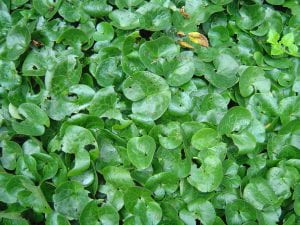 European ginger (Asarum europaeum): Yes, you can have thick, glossy, rounded heart-shaped leaves in the shadiest spot in your garden. Thanks to the European ginger, even the shadiest of spots can feature luscious, low-growing foliage. Their blooms are nothing to brag about, but European ginger has several other attributes. It’s shade- and drought-tolerant. It’s also deer resistant. European ginger reaches 6” tall and is hardy down to -30°F.
European ginger (Asarum europaeum): Yes, you can have thick, glossy, rounded heart-shaped leaves in the shadiest spot in your garden. Thanks to the European ginger, even the shadiest of spots can feature luscious, low-growing foliage. Their blooms are nothing to brag about, but European ginger has several other attributes. It’s shade- and drought-tolerant. It’s also deer resistant. European ginger reaches 6” tall and is hardy down to -30°F.
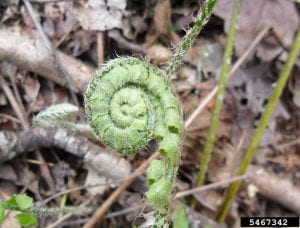 Christmas fern (Polystichum acrostichoides): Christmas fern got its name because it stays green through the holiday season. Like most ferns, this one is easy to establish and grow, provided you plant it in the right conditions. Christmas ferns require full or part shade and cool, moist, well-drained soil. It will not tolerate clay soils. When you plant Christmas fern in acidic, humus-rich soil, this robust fern will reward you with glossy-green fronds that grow up to 24” tall. Super healthy ones can grow as high as 36”. Silvery fiddleheads emerge in early spring. In the right place, Christmas ferns are a good border or accent plant that grow in clusters, rather creep in a continuous carpet. They also make a visual impact when planted in a thick mass. If you can envision evergreen fronds dusted with white snow, you’ll be hard pressed to write off this perennial evergreen.
Christmas fern (Polystichum acrostichoides): Christmas fern got its name because it stays green through the holiday season. Like most ferns, this one is easy to establish and grow, provided you plant it in the right conditions. Christmas ferns require full or part shade and cool, moist, well-drained soil. It will not tolerate clay soils. When you plant Christmas fern in acidic, humus-rich soil, this robust fern will reward you with glossy-green fronds that grow up to 24” tall. Super healthy ones can grow as high as 36”. Silvery fiddleheads emerge in early spring. In the right place, Christmas ferns are a good border or accent plant that grow in clusters, rather creep in a continuous carpet. They also make a visual impact when planted in a thick mass. If you can envision evergreen fronds dusted with white snow, you’ll be hard pressed to write off this perennial evergreen.
When it comes to gardening, it pays to keep an open mind and think beyond the norm. Green lawns aren’t the most environmentally friendly way to beautify your property. Gardens don’t have to adhere to rigid standards where sod plays the dominant role while perennials and annuals are supporting cast members. By using a variety of perennial evergreen groundcovers, you can achieve a beautiful landscape that you and your family can enjoy for years.
